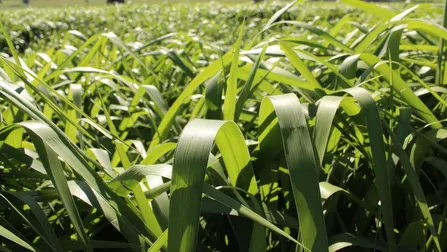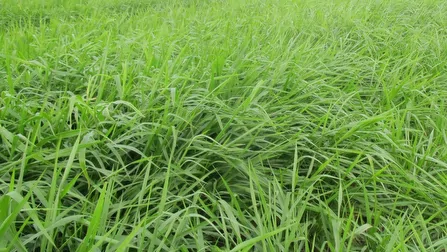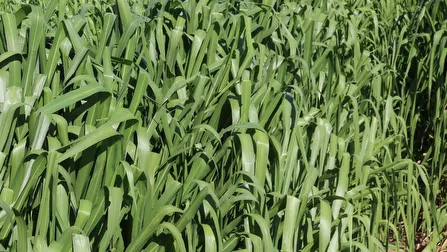A indicação da gramínea forrageira deve ser realizada por um responsável técnico através da análise dos diversos fatores da propriedade, tais como a condição climática, período de semeadura, região, tipo e fertilidade de solo, tecnologia de implantação, espécie e categoria animal, manejo, e vários outros.

MG19 Oásis
A Cultivar MG19 Oásis possui uma boa produção de forragem, boa qualidade nutricional e maciez da forragem produzida, sendo recomendada para produção de leite e carne, nas fases de cria, recria e engorda. É indicado para solos de média a alta fertilidade, no sistema intensivo de pastejo rotacionado com intervalos de descanso de 25 dias no período chuvoso.

MG18 Áries II
Devido a sua excelente qualidade nutricional, palatabilidade e porte médio, possui uma ampla aptidão para diversas categorias e espécies animais, sendo recomendada para todas as fases da produção de leite e carne, além de equinos, caprinos e ovinos.

MG11 Tijúca
É indicada para solos mal drenados e de média a baixa fertilidade, sendo assim uma boa opção para substituir a Humidicola nestas áreas. Comparada a Humidícola, possui a vantagem de apresentar melhor qualidade nutricional e as sementes não apresentarem dormência.

MG7 Tupã
É uma forrageira indicada para solos de média a baixa fertilidade, poucos profundos e também com cascalho. É uma ótima opção para regiões mais secas.

MG12 Paredão
O Paredão se destaca pela excelente produção de forragem e sua qualidade nutricional, sendo recomendada para a produção de leite e carne, nas fases de cria, recria e engorda. É indicado para solos de alta fertilidade, corrigidos e adubados, no sistema intensivo de pastejo rotacionado com intervalos de descanso de 25-28 dias. Pode ser utilizado também para ensilagem.

MG13 Braúna
A Braúna é indicada para solos de média a alta fertilidade. O crescimento mais prostrado de sua touceira (decumbente), seus talos mais finos e boa rebrota, facilitam o manejo desta gramínea, além do bom fechamento do solo.

Atlas
Indicada para solos de alta fertilidade. Pela boa tolerância ao alumínio do solo, possui bom desenvolvimento do seu sistema radicular conferindo a cultivar uma ótima rebrota e boa adaptação na seca.

MG-5 Vitória
É uma Braquiária com excelente potencial de produção de forragem (até 18 t/ha/ano de M.S.). É indicada pras solos de média a alta fertilidade. Possui tolerância a solos mal-drenados ou alagamentos de períodos curtos.

Capim Elefante Paraiso
É o primeiro híbrido de capim elefante propagado por sementes. Cultivar com alto potencial de produção de forragem (até 50 t/ha/ano de M.S.). Indicado para solos de alta fertilidade, corrigidos e adubados.

MG 4
Indicada para solos de média fertilidade para bovinos de cria, recria e engorda e leite. Pode ser utilizada para pastejo direto e fenação.

Dictyoneura (Llanero)
Indicado para solos de média a baixa fertilidade, arenosos, com acidez e excesso de umidade.

Andropogon
É uma forrageira indicada para solos de média a baixa fertilidade, ácidos, rasos e também com cascalho. Recomendado para bovinos nas fases de cria, recria e engorda, e também para equinos, ovinos e caprinos em regiões de clima mais áridos.

Aruana
É uma forrageira de boa qualidade nutricional indicada para bovinos, ovinos, equinos e caprinos.

Brizantha cv. Marandu
É indicada para solos de média a alta fertilidade. Pode ser usada em cria, recria e engorda de bovinos e produção leiteira, em pastejo direto, silagem e fenação.

Decumbens
Indicada para solo de média a baixa fertilidade, em pastejo direto pelos animais, servindo-se também para confecção de silagem e fenação, para bovino de recria e engorda e produção leiteira.

Humidícola (Quicuio)
Indicada para solos de média a baixa fertilidade e em áreas com encharcamento ou má-drenagem (Pantanal).

Massai
Panicum de porte médio. É indicado para solos de média fertilidade, para bovinos de cria, recria e engorda e produção leiteira. Pode ser utilizada para equinos, porém acompanhada de suplementação mineral e manejo adequado da pastagem.

Milheto
Forrageira de clima tropical indicada para solos de média a alta fertilidade. Pode ser utilizada na rotação de culturas (adubo verde e planta de cobertura) e na alimentação animal, por pastejo direto, silagem ou feno.

Miyagui
O Miyagui trata-se de uma planta cespitosa de crescimento ereto, de ciclo perene, porte médio a alto (até 2,50m de altura), com intenso perfilhamento basal, o colmo apresenta cerosidade, as folhas são de coloração verde escura podem atingir 120 cm e 5 cm de largura.

Mombaça
Indicada para solos de alta fertilidade e de climas amenos. Recomendado para bovinos em fase de recria e engorda e produção leiteira.

Piatã
Recomendada para solos de média fertilidade e textura arenosa. É utilizada em pastejo direto por bovinos de cria, recria e engorda, silagem ou fenação.

Ruziziensis
A ruziziensis é indicada para bovinos de recria e engorda. Possui boa qualidade nutricional e boa palatabilidade, podendo ser utilizada em pastejo direto ou fenação.

Setária
É indicada para solos média a baixa fertilidade. Possui boa tolerância aos solos úmidos e alagados, podendo substituir a humidícola nesses tipos de regiões com a vantagem das sementes não apresentarem dormência e melhor qualidade nutricional.

Tanzânia
Forrageira de excelente palatabilidade e qualidade nutricional, indicada para bovinos de cria, recria e engorda e produção leiteira.

Tobiatã
Indicada para solos de alta fertilidade, produz grande quantidade de forragem e de boa qualidade nutricional.